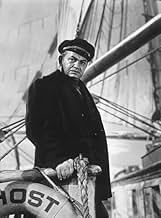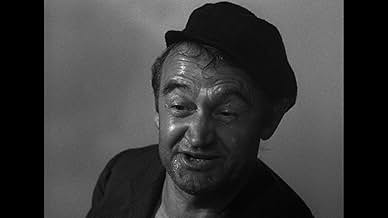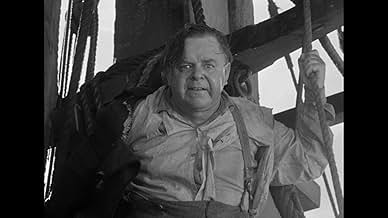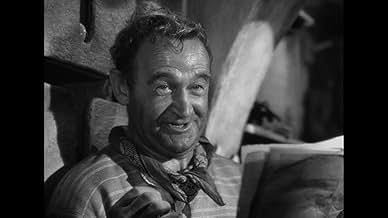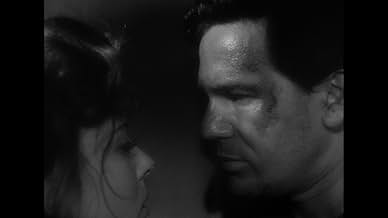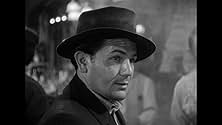NOTE IMDb
7,5/10
4,7 k
MA NOTE
Ajouter une intrigue dans votre langueAfter being fished out of the sea by a sailing ship, three fugitives find themselves prisoners of the ship's brutal skipper who refuses to put them ashore, and they hatch an escape plan duri... Tout lireAfter being fished out of the sea by a sailing ship, three fugitives find themselves prisoners of the ship's brutal skipper who refuses to put them ashore, and they hatch an escape plan during a crew mutiny.After being fished out of the sea by a sailing ship, three fugitives find themselves prisoners of the ship's brutal skipper who refuses to put them ashore, and they hatch an escape plan during a crew mutiny.
- Nommé pour 1 Oscar
- 2 nominations au total
Ernie Adams
- Pickpocket
- (non crédité)
Cliff Clark
- First Detective
- (non crédité)
Jeane Cowan
- Singer
- (non crédité)
Richard Cramer
- Bartender
- (non crédité)
William Gould
- Second Detective
- (non crédité)
Ralf Harolde
- Agent Getting Johnson Shanghaied
- (non crédité)
Oscar 'Dutch' Hendrian
- Crewman
- (non crédité)
Histoire
Le saviez-vous
- AnecdotesThe first movie to have its world premiere on a ship: the luxury liner "America", during a trip from San Francisco to Los Angeles.
- GaffesUntil the era of the 1st World War, the practice on board a ship was to call orders for the helmsman to move the tiller either to port or to starboard. Calling "hard a-port" meant moving the tiller to port, which means the rudder and the vessel, will then move to starboard. With wheel steering, putting the helm/tiller to port, means spinning the wheel to starboard. Ships no longer use this system - these days helm directions refer to the desired turn of the rudder/vessel. The James Cameron movie "Titanic" also contained a similar scene, which generated a lot of puzzlement. It IS a bit confusing at first, unless one is a sailor and is familiar with tiller steering.
- Citations
Humphrey Van Weyden: There's a price no man will pay for living.
- Versions alternativesThe film was cut by approximately 12 minutes down to less than 90 minutes for re-issue. The deleted footage consisted of little, but integral, moments throughout the story which added considerably to the quality of the film as a whole. For many years, the only known existing print of the original 99-minute theatrical version was a 16mm print which belonged to the film's star, John Garfield. However, Warner Brothers studio recently discovered a 35mm print of this original version at the Museum of Modern Art in New York City. It was subsequently restored and used for distribution on DVD and Blu Ray.
- ConnexionsEdited into Le loup de mer (1993)
- Bandes originalesHello! Ma Baby
(uncredited)
Music by Joseph E. Howard
Lyrics by Ida Emerson
Played on piano and sung by Jeane Cowan in the bar
Commentaire à la une
Jack London's novel "The Sea Wolf" is one of those old chestnuts that seemingly won't go away. It has served as an subject for movies almost since they began being made, including Italian and Russian versions. This 1941 Warner version remains the definitive screen adaptation, however, in spite of numerous alterations to the plot of the original novel.
In the book, Wolf Larson is a giant Norwegian sea captain who rules his ship by virtue of his strength and brutality. He is the embodiment of the old joke which runs: "Yea though I walk through the valley of the shadow of death I shall fear no evil, because I am the meanest, toughest son of a b--- in the valley!" One would ordinarily think that the five foot six inches tall Edward G. Robinson would be a poor choice to play such a character. However, Robinson is a good enough actor, and a forceful enough screen personality, to carry it off.
John Garfield is equally perfect as a chip-on-the-shoulder working class seaman who dares to oppose Larson. He's a perfect foil for Robinson, and it's great fun watching the two of them snarl at each other like a couple of wild dogs.
Ida Lupino and Alexander Knox do some of their best work as the two castaways rescued by Larson's vessel. Lupino plays a female ex-convict trying to conceal her past, and Knox is an effete writer whom Larson decides to educate in what he considers the ways of the real world.
Gene Lockhart and Barry Fitzgerald are equally good in supporting roles as the ship's drunken and degraded doctor, and the thoroughly corrupt cook. It is particularly refreshing to see Fitzgerald play a really unpleasant character for a change, and one can only wonder why he didn't get more parts like this. In The Sea Wolf, Fitzgerald plays an individual so slimy that one almost expects to see him leave a trail behind him, like a slug.
Director Michael Curtiz managed to impart a dank and foggy atmosphere to The Sea Wolf that seems to suit the story perfectly, and that feeling is enhanced by Erich Korngold's moody score. The first view of the schooner "Ghost", looming out of the fog like a real ghost, is particularly memorable.
Granted, the ending differs radically from that of the book. This film's ending seems rather more satisfying than London's was, however. London was virtually forced to end the novel the way he did because it is presented in narrative form and the writer, Van Wyden, is the one actually telling the story. Warner Brothers could change the ending because, as a movie, the story was no longer restricted to Van Wyden's point of view.
In the book, Wolf Larson is a giant Norwegian sea captain who rules his ship by virtue of his strength and brutality. He is the embodiment of the old joke which runs: "Yea though I walk through the valley of the shadow of death I shall fear no evil, because I am the meanest, toughest son of a b--- in the valley!" One would ordinarily think that the five foot six inches tall Edward G. Robinson would be a poor choice to play such a character. However, Robinson is a good enough actor, and a forceful enough screen personality, to carry it off.
John Garfield is equally perfect as a chip-on-the-shoulder working class seaman who dares to oppose Larson. He's a perfect foil for Robinson, and it's great fun watching the two of them snarl at each other like a couple of wild dogs.
Ida Lupino and Alexander Knox do some of their best work as the two castaways rescued by Larson's vessel. Lupino plays a female ex-convict trying to conceal her past, and Knox is an effete writer whom Larson decides to educate in what he considers the ways of the real world.
Gene Lockhart and Barry Fitzgerald are equally good in supporting roles as the ship's drunken and degraded doctor, and the thoroughly corrupt cook. It is particularly refreshing to see Fitzgerald play a really unpleasant character for a change, and one can only wonder why he didn't get more parts like this. In The Sea Wolf, Fitzgerald plays an individual so slimy that one almost expects to see him leave a trail behind him, like a slug.
Director Michael Curtiz managed to impart a dank and foggy atmosphere to The Sea Wolf that seems to suit the story perfectly, and that feeling is enhanced by Erich Korngold's moody score. The first view of the schooner "Ghost", looming out of the fog like a real ghost, is particularly memorable.
Granted, the ending differs radically from that of the book. This film's ending seems rather more satisfying than London's was, however. London was virtually forced to end the novel the way he did because it is presented in narrative form and the writer, Van Wyden, is the one actually telling the story. Warner Brothers could change the ending because, as a movie, the story was no longer restricted to Van Wyden's point of view.
- robertguttman
- 8 févr. 2003
- Permalien
Meilleurs choix
Connectez-vous pour évaluer et suivre la liste de favoris afin de recevoir des recommandations personnalisées
Détails
- Date de sortie
- Pays d’origine
- Langue
- Aussi connu sous le nom de
- The Sea Wolf
- Lieux de tournage
- Société de production
- Voir plus de crédits d'entreprise sur IMDbPro
Box-office
- Budget
- 1 013 217 $US (estimé)
- Montant brut mondial
- 6 192 $US
- Durée1 heure 40 minutes
- Couleur
- Rapport de forme
- 1.37 : 1
Contribuer à cette page
Suggérer une modification ou ajouter du contenu manquant

Lacune principale
By what name was Le vaisseau fantôme (1941) officially released in India in English?
Répondre

